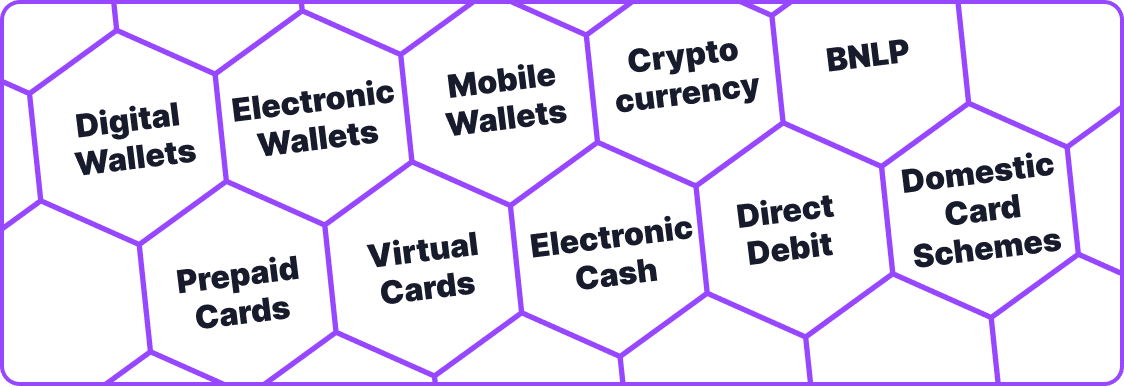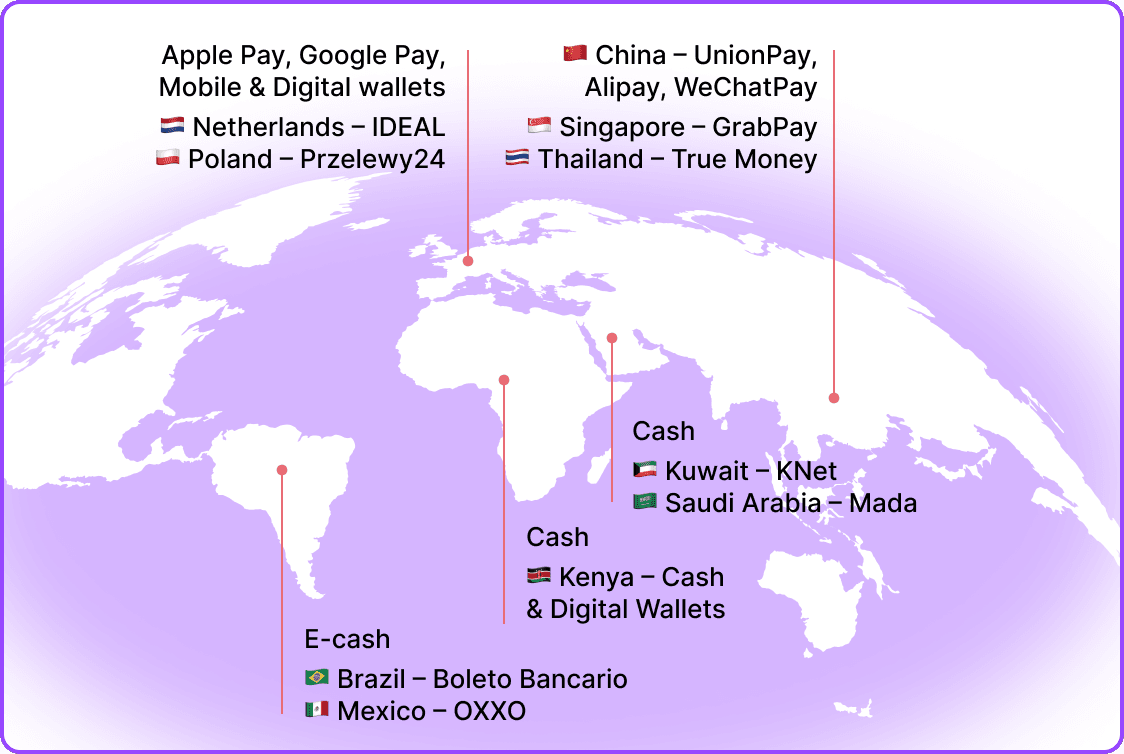
In today’s digital era, the way we make payments has drastically transformed. From the ancient trade of goods to the emergence of digital wallets, our transaction methods are continuously progressing. For businesses, it is vital to grasp these alternative payment options to remain up-to-date and competitive.
What are Alternative Payment Methods?
The meaning behind alternative payment methods (APMs) refers to any type of payment that goes beyond traditional cash or major international credit card brands. This includes payment alternatives like domestic cards, digital wallets such as Apple Pay and Google Pay, bank transfers, and even cryptocurrencies.
As highlighted in the Global Payments Report for 2021, APMs are increasingly popular, with digital wallets currently capturing 49% of global e-commerce expenditure. These methods provide both consumers and businesses with a more streamlined, convenient, and often cost-effective approach to managing transactions.
History of the Alternative Forms of Payment
Trade has always been a fundamental aspect of human societies, which means there always have been transactions of some sort. Before standardised currency existed, people relied on bartering as the primary method for exchanging goods and services. This meant that individuals could trade directly with one another without any intermediaries involved, making bartering the first-ever alternative payment method.
However, as communities grew and trade routes became more complex, the need for a more uniform system arose. Localised coins unique to specific regions or communities were introduced to facilitate trade.
As nations emerged, they introduced standardised currency in the form of national money, supported by the trust and authority of their governments. These currencies played a vital role in streamlining and expanding trade.
With the rapid advancement of technology, digital payment options gained momentum. Platforms like PayPal introduced a new way to conduct online transactions, circumventing the need for traditional banking systems. Additionally, digital wallets such as Apple Pay offered users a secure platform to store their payment information and effortlessly carry out transactions.
In the last decade, blockchain technology and cryptocurrencies have revolutionised and introduced a decentralised system to the way we pay. With no reliance on any specific national economy and the possibility of maintaining anonymity, they represent the forefront of digital transactions.
Top 10 Alternative Payment Methods
Let’s take a look at different types of alternative payment methods that are reshaping the landscape of commerce.

Digital Wallets
Utilising Near Field Communication (NFC) technology, digital wallets provide a secure means of storing multiple card details. Making transactions using digital wallets is as simple as tapping your device on NFC-enabled terminals.
Electronic Wallets
E-wallets, also known as electronic wallets, are convenient online platforms that simplify the process of online shopping.
Examples of alternative payment methods in this category include platforms like PayPal. They allow users to store funds and make purchases across multiple online platforms without the hassle of repeatedly entering payment details. They serve as a digital link between merchants and consumers, ensuring seamless and secure online transactions.
Mobile Wallets
Mobile wallets represent the next stage in the development of digital wallets, designed to optimise user experience on smartphones and tablets.
In addition to securely storing payment information, these innovative platforms can accommodate loyalty cards, event tickets, and boarding passes. Apple Wallet, which pairs seamlessly with Apple Pay, serves as a prime example of the versatile functionality and convenience offered by mobile wallets.
Open Banking Payments
Open banking (often referred to as pay-by-bank) is a relatively new way to make payments that connects directly to your bank account. Instead of entering card details, customers can pay using their bank's secure system, making the process faster and safer. This payment method uses APIs (a type of software connection) to move money instantly from the customer's bank to the merchant’s account.
It often has lower fees compared to traditional card payments and provides better security since users confirm the payment directly through their bank. With options like Noda, open banking is a payment method quickly growing in popularity in multiple markets globally.
Cryptocurrency
Cryptocurrencies, often referred to as the digital gold of our time, present a decentralised approach to finance.
While Bitcoin is the most widely recognised currency in this realm, there are also other notable options such as Ethereum and Ripple. These digital assets offer users anonymity and heightened security, all while operating independently from traditional banking systems. It's no wonder that they have emerged as a fascinating and revolutionary aspect of modern-day finance.
BNPL (Buy Now, Pay Later)
The e-commerce landscape is being revolutionised by buy now, pay later (BNPL) services. Platforms such as Klarna and Afterpay grant consumers the convenience of instant purchases coupled with the freedom to defer payment or opt for installment plans.
Besides increasing sales for merchants, this approach provides consumers with a more manageable way to budget their expenses, provided they are not taking on too much debt.
Prepaid Cards
Prepaid cards, whether physical or digital, provide a predetermined spending limit. They are ideal for budgeting, online shopping, or gift-giving purposes. Unlike traditional credit cards, prepaid cards eliminate the risk of overspending, making them a popular choice among consumers.
Virtual Cards
Virtual cards provide an extra layer of security for online transactions. Designed for one-time use, they prevent the reuse of transaction information even if it gets intercepted. This added protection benefits both businesses and consumers alike.
Electronic Cash (e-cash)
E-cash systems provide a solution that connects online shopping with cash payments.
For example, in Brazil, systems like Boleto generate a unique barcode at checkout. Consumers can then pay for their purchase in cash at designated retail locations. This allows individuals without digital banking to participate in e-commerce seamlessly.
Direct Debit
Recurring billing models greatly benefit from the use of direct debit. With consumer authorisation, businesses can conveniently deduct the required payment directly from their bank accounts, ensuring prompt and hassle-free transactions without manual money transfers. This payment method is widely used by subscription services and utility bill providers globally.
Domestic Card Schemes
To cater to the preferences of local residents, domestic card schemes such as Bancontact in Belgium or Carte Bancaire in France provide card services specifically designed for their respective regions. While they function similarly to global leaders like Visa or Mastercard, these domestic schemes are tailored and optimised for local transactions.
Benefits of Accepting Alternative Payment Methods
- Increased Customer Reach: By offering a variety of payment methods, businesses can cater to a broader audience, including those without traditional banking access.
- Enhanced Conversion Rates: A seamless payment experience can reduce cart abandonment rates, leading to higher conversions.
- Improved Customer Experience: Giving customers their preferred payment option enhances their shopping experience.
- Security and Fraud Prevention: Many alternative payment processing come with built-in security features, reducing the risk of fraud.
- Future-Proofing: As the digital economy evolves, businesses that adopt diverse payment methods are better positioned for future trends.
Alternative Payment Methods Around the World
In today's globalised world of commerce, it is essential for businesses to understand regional payment preferences. Different regions have their own distinct mix of traditional and alternative payment methods, which are influenced by factors such as culture, economy, and technology.

North America
In North America, the payment landscape has experienced a notable shift, with digital wallets emerging as the preferred method.
According to data from Oberlo in 2022, digital wallets accounted for 32% of online transactions, surpassing credit cards, which currently stand at 31%. This significant change reflected an increasing acceptance and adoption of technological innovations within the payment sector. Other widely used methods included debit cards (19%) and popular services such as Apple Pay, Google Pay, PayPal, and Venmo.
South America
The payment landscape in South America is experiencing rapid changes. Although, according to the Beyond Borders study, credit card usage has seen a slight decline from 55% in 2020 to 51% in 2022, alternative payment methods are gaining popularity. E-cash alternative payment solutions, specifically designed for the region's significant unbanked population, are on the rise. Notable examples of these solutions include Boleto Bancário in Brazil and OXXO in Mexico.
Europe
In Europe, digital wallets have followed the global trend by surpassing traditional card payments. According to Ecommerce News, in 2021, 44% of online transactions in Europe were made using digital wallets, while credit and debit cards combined accounted for 42%. Additionally, local payment methods such as iDEAL in the Netherlands and Przelewy24 in Poland have played a significant role.
Africa
The payment landscape in Africa is shaped by its distinctive obstacles, including limited banking infrastructure. To address this issue, mobile wallets have emerged as a viable solution, particularly in regions with a substantial rural population. According to Statista, as of 2022 cash on delivery remained prevalent in countries like Nigeria (66%) and South Africa (40%), but there was an increasing adoption of digital wallet usage in countries like Kenya, where it accounted for 19% of online transactions.
Middle East
In the Middle East, cash has traditionally been the dominant form of payment. However, as internet and smartphone usage increases in the region, there is a growing trend towards the use of mobile wallets. Government-supported payment networks like KNet in Kuwait and Mada in Saudi Arabia are also gaining popularity.
Asia Pacific
The Asia Pacific region, specifically China, significantly influences the world of alternative payment systems. A major player in this domain is China's UnionPay, which accounts for an impressive 45% of global card spending.
Additionally, mobile payments have experienced remarkable growth with transactions amounting to $120 trillion in 2020. In this realm, Alipay and WeChat Pay dominate, collectively holding over 90% market share. Other regions have preferred local choices such as GrabPay in Singapore and True Money in Thailand.
How to Choose Alternative Payment Methods for Your Business
When determining which alternative payment provider to choose, you should identify the payment methods your business would most benefit from. Here, several factors come into play.
- Demographics: Understand your target audience. Younger generations might prefer digital wallets, while others might lean towards bank transfers or even cryptocurrencies.
- Geographical Reach: Consider global alternative payment methods if you're targeting a wide geographic area. Alternatively, choose methods specific to the region. For instance, Alipay is essential for the Chinese market.
- Transaction Fees: Different payment methods come with varying fee structures. Ensure that the chosen method is cost-effective for your business.
- Integration with Existing Systems: The chosen payment method should seamlessly integrate with your current business systems and platforms.
- Security: Prioritise payment methods known for robust security features to protect your business and customers.
- Flexibility and Scalability: As your business grows, your payment needs might change. Opt for methods that can scale your business.
Conclusion
The world of finance is constantly changing, and alternative payment methods are leading the way in this transformation. For businesses, adopting these alternative payment options is not just about following trends; it's about staying ahead, improving the customer experience, and accessing new markets.
As the boundaries between commerce, technology, and finance become more blurred, businesses that can adapt and embrace innovation will undoubtedly thrive in the global marketplace.
Alternative Payments with Noda
At Noda, we offer a versatile approach to payments, covering open banking and traditional card payments to give both merchants and customers the flexibility they need.
Noda’s extensive coverage includes over 2000 banks in the UK, Europe, Brazil and Canada, and is continuously expanding. Beyond just processing payments, we also provide tools for AI-powered financial analytics and user-friendly identity verification, helping businesses gain deeper insights into customer behaviour and streamline their KYC operations.
By integrating Noda, you’re not just choosing a payment provider – you’re opting for a solution that enhances the entire transaction experience, benefiting both your business and your customers. Talk to us today to discuss how your business can benefit from open banking with Noda!
FAQs
How do I accept alternative payment methods with Noda?
At Noda, we support the majority of alternative payment methods. With our payment platform, merchants can integrate mobile wallets such as ApplePay and cryptocurrency deposits.
What are the benefits of accepting alternative payment methods?
Accepting alternative payment methods increases customer reach, enhances conversion rates, and improves the overall customer experience. Additionally, they offer built-in security features and position businesses for future digital economy trends.
Latest from Noda

Plaid Review for Merchants: Data, Payments, Pros & Cons, and More

Open Banking Costs in the UK: What Ecommerce Merchants Should Know

How Does Open Banking Work? Guide for Merchants & Businesses


